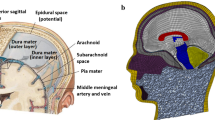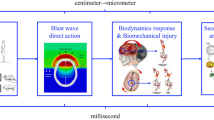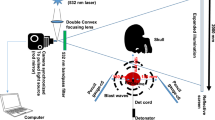Abstract
Soldiers suffer from multiple explosions in complex battlefield environment resulting in aggravated brain injuries. At present, researches mostly focus on the damage to human body caused by single explosion. In the repetitive impact study, small animals are mainly used for related experiments to study brain nerve damage. No in-depth research has been conducted on the dynamic response and damage of human brain under repetitive explosion shock waves. Therefore, this study use the Euler–Lagrange coupling method to construct an explosion shock wave-head fluid–structure coupling model, and numerically simulated the brain dynamic response subjected to single and repetitive blast waves, obtained flow field pressure, skull stress, skull displacement, intracranial pressure to analyze the brain damage. The simulation results of 100 g equivalent of TNT exploding at 1 m in front of the craniocerebral show that repetitive blast increase skull stress, intracranial pressure, skull displacement, and the damage of brain tissue changes from moderate to severe. Repetitive blasts show a certain cumulative damage effect, the severity of damage caused by double blast is 122.5% of single shock, and the severity of damage caused by triple blast is 105.9% of double blast and 131.5% of single blast. The data above shows that it is necessary to reduce soldiers’ exposure from repetitive blast waves.







Similar content being viewed by others
References
Bazarian, J. J., K. Donnelly, D. R. Peterson, et al. The relation between posttraumatic stress disorder and mild traumatic brain injury acquired during Operations Enduring Freedom and Iraqi Freedom. J. Head Trauma Rehabil. 28(1):1–12, 2013.
Bolander, R., B. Mathie, C. Bir, et al. Skull flexure as a contributing factor in the mechanism of injury in the rat when exposed to a shock wave. Ann. Biomed. Eng. 39:2550, 2011.
Brix, K. A., D. L. Brody, J. B. Grimes, et al. Military blast exposure and chronic neurodegeneration: summary of working groups and expert panel findings and recommendations. J. Neurotrauma 34(S1):S18–S25, 2017.
Cai, Z., X. Huang, Y. Xia, et al. Study on behind helmet blunt trauma caused by high-speed bullet. Appl. Bionics Biomech. 7:1–12, 2020.
Cai, Z., Y. Xia, Z. Bao, et al. Creating a human head finite element model using a multi-block approach for predicting skull response and brain pressure. Comput. Methods Biomech. Biomed. Eng. 22(2):169–179, 2019.
Cai, Z., Y. Xia, and X. Huang. Analyses of pedestrian’s head-to-windshield impact biomechanical responses and head injuries using a head finite element model. J. Mech. Med. Biol. 20(01):1950063, 2020.
Calabrese, E., F. Du, R. H. Garman, et al. Diffusion tensor imaging reveals white matter injury in a rat model of repetitive blast-induced traumatic brain injury. J. Neurotrauma 31(10):938–950, 2014.
Cheng, J., J. Gu, Y. Ma, et al. Development of a rat model for studying blast-induced traumatic brain injury. J. Neurol. Sci. 294(1–2):23–28, 2010.
Choi, J. H., W. A. Greene, A. J. Johnson, et al. Pathophysiology of blast-induced ocular trauma in rats after repeated exposure to low-level blast overpressure. Clin. Exp. Ophthalmol. 43(3):239–246, 2015.
Heltemes, K. J., T. L. Holbrook, A. J. MacGregor, et al. Blast-related mild traumatic brain injury is associated with a decline in self-rated health amongst US military personnel. Injury 43(12):1990–1995, 2012.
Horstemeyer, M. F., P. R. Berthelson, J. Moore, et al. A mechanical brain damage framework used to model abnormal brain tau protein accumulations of national football league players. Ann. Biomed. Eng. 47:1873–1888, 2019.
Kamimori, G. H., L. A. Reilly, C. R. LaValle, et al. Occupational overpressure exposure of breachers and military personnel. Shock Waves 27(6):837–847, 2017.
King, A.I., K.H. Yang, L. Zhang, et al. Is head injury caused by linear or angular acceleration. In IRCOBI Conference, Lisbon, Portugal, 2003, p. 12.
Kuehn, R., P. F. Simard, I. Driscoll, et al. Rodent model of direct cranial blast injury. J. Neurotrauma 28(10):2155–2169, 2011.
Lee, E., M. Finger, and W. Collins. JWL Equation of State Coefficients for High Explosives. Livermore: Lawrence Livermore National Lab. (LLNL), 1973.
Long, J. B., T. L. Bentley, K. A. Wessner, et al. Blast overpressure in rats: recreating a battlefield injury in the laboratory. J. Neurotrauma 26(6):827–840, 2009.
Madouh, F. A., and K. T. Ramesh. The Influence of shear anisotropy in mTBI: a white matter constitutive model. Ann. Biomed. Eng. 47:1960–1970, 2019.
Mazurkiewicz-Kwilecki, I. M. Single and repeated air blast stress and brain histamine. Pharmacol. Biochem. Behav. 12(1):35–39, 1980.
McElhaney, J. H., J. L. Fogle, J. W. Melvin, et al. Mechanical properties of cranial bone. J. Biomech. 3(5):495–511, 1970.
Meabon, J. S., B. R. Huber, D. J. Cross, et al. Repetitive blast exposure in mice and combat veterans causes persistent cerebellar dysfunction. Sci. Transl. Med. 8(321):321ra6, 2016.
Peskind, E. R., E. C. Petrie, D. J. Cross, et al. Cerebrocerebellar hypometabolism associated with repetitive blast exposure mild traumatic brain injury in 12 Iraq war Veterans with persistent post-concussive symptoms. Neuroimage 54:S76–S82, 2011.
Proctor, J. L., W. L. Fourney, U. H. Leiste, et al. Rat model of brain injury caused by under-vehicle blast-induced hyperacceleration. J. Trauma Acute Care Surg. 77(3):S83–S87, 2014.
Rogers, G. F. C., and Y. R. Mayhew. Thermodynamic and transport properties of fluids. Fluid Phase Equilib. 83(2):85–92, 1994.
Rowson, S., and S. M. Duma. Development of the STAR evaluation system for football helmets: integrating player head impact exposure and risk of concussion. Ann. Biomed. Eng. 39(8):2130–2140, 2011.
Sadovskyi, M. A. Mechanical Action of Air Shock Waves of Explosion, Based on Experimental Data. Moscow: Izd. Akad. Nauk SSSR, 1952.
Säljö, A., F. Bao, K. G. Haglid, et al. Blast exposure causes redistribution of phosphorylated neurofilament subunits in neurons of the adult rat brain. J. Neurotrauma 17(8):719–726, 2000.
Säljö, A., B. Svensson, M. Mayorga, et al. Low-level blasts raise intracranial pressure and impair cognitive function in rats. J. Neurotrauma 26(8):1345–1352, 2009.
Shridharani, J., G. W. Wood, M. B. Panzer, et al. Porcine head response to blast. Front. Neurol. 3:70, 2012.
Singh, D., and D. Cronin. Multi-scale modeling of head kinematics and brain tissue response to blast exposure. Ann. Biomed. Eng. 47:1993–2004, 2019.
Townsend, M. T., E. Alay, M. Skotak, et al. Effect of tissue material properties in blast loading: coupled experimentation and finite element simulation. Ann. Biomed. Eng. 47:2019–2032, 2019.
Unnikrishnan, G., H. Mao, A. Sundaramurthy, et al. A 3-D rat brain model for blast-wave exposure: effects of brain vasculature and material properties. Ann. Biomed. Eng. 47:2033–2044, 2019.
Vogel, E. W., M. B. Panzer, F. N. Morales, et al. Direct observation of low strain, high rate deformation of cultured brain tissue during primary blast. Ann. Biomed. Eng. 48:1196–1206, 2020.
Wang, Y., Y. Wei, S. Oguntayo, et al. Tightly coupled repetitive blast-induced traumatic brain injury: development and characterization in mice. J. Neurotrauma 28(10):2171–2183, 2011.
Ward, C., M. Chan, and A. Nahum. Intracranial pressure – a brain injury criterion. SAE Technical Paper 801304, 1980.
Yeoh, S., E. D. Bell, and K. L. Monson. Distribution of blood–brain barrier disruption in primary blast injury. Ann. Biomed. Eng. 41(10):2206–2214, 2013.
Acknowledgments
We acknowledge the support from National Natural Science Foundation of China (No. 11972158), Military Commission Science and Technology Committee Basic Strengthening Program Technology Fund (2020-JCJQ-JJ-356) and (2019-JCJQ-JJ-150), Educational Commission of Hunan Province of China (18A188).
Author information
Authors and Affiliations
Corresponding authors
Additional information
Associate Editor Stefan M Duma oversaw the review of this article.
Publisher's Note
Springer Nature remains neutral with regard to jurisdictional claims in published maps and institutional affiliations.
Rights and permissions
About this article
Cite this article
Huang, X., Hu, X., Zhang, L. et al. Craniocerebral Dynamic Response and Cumulative Effect of Damage Under Repetitive Blast. Ann Biomed Eng 49, 2932–2943 (2021). https://doi.org/10.1007/s10439-021-02746-7
Received:
Accepted:
Published:
Issue Date:
DOI: https://doi.org/10.1007/s10439-021-02746-7




